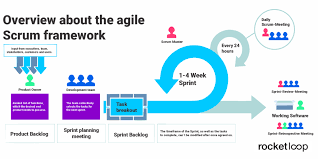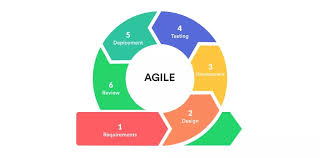Understanding Agile Scrum Software Development Methodology
Agile Scrum is a popular software development methodology that emphasizes iterative development, flexibility, and collaboration. It is based on the principles of the Agile Manifesto and uses the Scrum framework to help teams deliver high-quality software products efficiently.
In Agile Scrum, projects are divided into small increments called sprints, typically lasting 2-4 weeks. Each sprint begins with a planning meeting where the team defines the goals and tasks to be completed. Throughout the sprint, daily stand-up meetings are held to track progress and address any issues that arise.
One of the key features of Agile Scrum is its emphasis on collaboration and communication. Team members work closely together, share ideas, and provide feedback regularly. This helps ensure that everyone is aligned on project goals and can respond quickly to changes or challenges.
The Scrum framework includes several roles, including the Product Owner, Scrum Master, and Development Team. The Product Owner is responsible for defining project requirements and priorities, while the Scrum Master facilitates the team’s progress and removes any obstacles they may encounter.
Overall, Agile Scrum promotes adaptability, transparency, and continuous improvement. By breaking projects into smaller chunks and focusing on delivering value in each sprint, teams can respond quickly to feedback and changes in requirements. This results in faster delivery times, higher quality products, and increased customer satisfaction.
Whether you’re new to Agile methodologies or looking to improve your current processes, incorporating Agile Scrum into your software development projects can help you streamline your workflow and achieve better results.
9 Essential Tips for Mastering Agile Scrum in Software Development
- Embrace change and adapt quickly to new requirements.
- Prioritize the product backlog based on value and urgency.
- Hold daily stand-up meetings to ensure team alignment.
- Use sprints to break down work into manageable time frames.
- Encourage collaboration between cross-functional teams.
- Focus on delivering a potentially shippable product increment each sprint.
- Conduct regular retrospectives to improve processes continuously.
- Maintain clear communication with stakeholders throughout the project.
- Ensure that all team members understand their roles and responsibilities.
Embrace change and adapt quickly to new requirements.
Embracing change and adapting quickly to new requirements is a fundamental principle of Agile Scrum software development methodology. By remaining flexible and responsive to evolving needs, teams can ensure that their projects stay on track and deliver maximum value to stakeholders. This proactive approach not only fosters innovation and creativity but also allows for continuous improvement throughout the development process. In an ever-changing technological landscape, the ability to embrace change is key to success in Agile Scrum projects.
Prioritize the product backlog based on value and urgency.
In Agile Scrum software development methodology, it is crucial to prioritize the product backlog based on value and urgency. By focusing on delivering the most valuable and urgent features first, teams can ensure that they are meeting the needs of their customers and stakeholders effectively. This approach helps maximize the return on investment and ensures that the team is working on tasks that have the most significant impact on the project’s success. Prioritizing the product backlog in this manner also allows for better resource allocation and helps teams stay focused on delivering value in each sprint.
Hold daily stand-up meetings to ensure team alignment.
In Agile Scrum software development methodology, holding daily stand-up meetings is a crucial practice to ensure team alignment. These short meetings provide an opportunity for team members to communicate their progress, discuss any roadblocks they may be facing, and coordinate their efforts effectively. By fostering regular communication and collaboration through daily stand-ups, teams can stay focused on project goals, address issues promptly, and maintain a shared understanding of the work being done.
Use sprints to break down work into manageable time frames.
Using sprints to break down work into manageable time frames is a key tip in Agile Scrum software development methodology. By dividing projects into smaller increments typically lasting 2-4 weeks, teams can focus on specific tasks and goals within a defined timeframe. This approach helps increase productivity, maintain momentum, and allows for adjustments to be made more easily based on feedback received during each sprint. Breaking down work into manageable time frames through sprints enables teams to deliver high-quality software products efficiently while staying flexible and responsive to changing requirements.
Encourage collaboration between cross-functional teams.
Encouraging collaboration between cross-functional teams is a key aspect of Agile Scrum software development methodology. By bringing together individuals with diverse skills and expertise, teams can leverage different perspectives to solve problems more effectively and deliver high-quality products. This collaborative approach fosters innovation, enhances communication, and promotes a sense of shared ownership over project outcomes. By working closely together, cross-functional teams can leverage their collective strengths to overcome challenges, adapt to changes quickly, and ultimately achieve success in their software development projects.
Focus on delivering a potentially shippable product increment each sprint.
In Agile Scrum software development methodology, it is crucial to focus on delivering a potentially shippable product increment each sprint. By breaking down the project into manageable chunks and setting the goal of producing a usable product at the end of each sprint, teams can ensure continuous progress and feedback. This approach not only helps in maintaining momentum but also allows for early testing and validation, leading to quicker iterations and ultimately a higher-quality end product.
Conduct regular retrospectives to improve processes continuously.
Conducting regular retrospectives is a crucial aspect of Agile Scrum software development methodology. By taking the time to reflect on past sprints and projects, teams can identify what worked well and areas that need improvement. This practice allows teams to continuously refine their processes, address any inefficiencies, and implement changes that lead to better outcomes in future sprints. Regular retrospectives promote a culture of continuous improvement within the team, fostering collaboration and innovation while ensuring that lessons learned are applied to enhance overall productivity and quality of work.
Maintain clear communication with stakeholders throughout the project.
Maintaining clear communication with stakeholders throughout the project is crucial in Agile Scrum software development methodology. By keeping stakeholders informed and engaged, teams can ensure that project goals are aligned with business objectives and that any changes or challenges are addressed promptly. Clear communication helps build trust, manage expectations, and foster collaboration, ultimately leading to successful project outcomes. Stakeholder involvement throughout the development process also allows for valuable feedback and insights that can help improve the quality of the final product.
Ensure that all team members understand their roles and responsibilities.
It is crucial in Agile Scrum software development methodology to ensure that all team members have a clear understanding of their roles and responsibilities. This clarity helps promote effective collaboration, communication, and accountability within the team. When each team member knows what is expected of them and how their role contributes to the project’s success, it fosters a sense of ownership and commitment to achieving common goals. By defining roles and responsibilities upfront, teams can work more efficiently, minimize misunderstandings, and deliver high-quality software products consistently.




